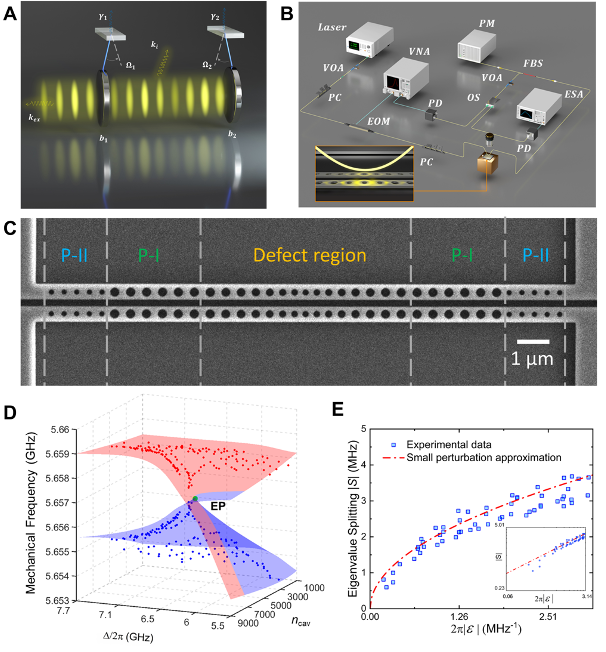The research group led by Professor Yidong Huang from the Department of Electronic Engineering at Tsinghua University recently reported a breakthrough in the study of on-chip exceptional points (EPs). Associate Professor Kaiyu Cui and her student team constructed a tunable non-Hermitian mechanical system with an optomechanical zipper cavity. By tailoring the interaction between two mechanical modes through the optical field, the team demonstrated anti-parity-time-symmetry mechanical EPs in on-chip systems for the first time. This study provides an integrated on-chip platform for investigating the related physics of mechanical EPs, such as non-Hermitian phenomena, nonlinear effects, and phononic topology. It also suggests possible solutions to technical obstacles in applications such as ultrasensitive sensing and precision measurement of physical quantities.

On-chip mechanical exceptional points based on an optomechanical zipper cavity: (A) Equivalent physical model; (B) Experimental setup schematic; (C) Scanning electron microscope image of the optomechanical zipper cavity; (D) Topological surface of resonant frequencies corresponding to different parameters; (E) Eigenvalue splitting with 1/2 order response near the EPs.
The non-Hermitian system, which is coupled with the external environment, differs significantly from the Hermitian system in terms of physical properties. EPs are special degenerate points of spectra that exist in the non-Hermitian system. Physical effects and applications related to EPs have attracted wide attention on topics such as asymmetric mode conversion, single-mode lasers, and their high-sensitivity sensing capability based on Nth-order mode splitting near the EPs. However, studies to date have focused primarily on optical EPs. Phenomena and applications related to EPs in other physical systems are still expected to be explored further. As mechanical modes can be easily coupled with many physical quantities, a multiphysics system built upon this foundation will allow a higher degree of freedom for the study of EPs. In addition, with regard to ultrasensitive sensing, mechanical EPs have shown greater potentials in application. However, gigahertz mechanical EPs on chips have remained elusive due to great challenges in the manipulation of the high-frequency mechanical modes.
In this study, researchers proposed to realize on-chip mechanical EPs through anti-parity-time-symmetry, mechanical Hamiltonian in an optomechanical zipper cavity, wherein two near-degenerate gigahertz mechanical breathing modes were coupled via a colocalized optical mode. The coherent and dissipative coupling mechanisms between two mechanical modes were constructed in the optomechanical cavity with resolved-sideband property. During the experiment, the strength of dissipative and coherent couplings between two mechanical oscillators was controlled by adjusting the frequency and power of the pump light to compensate for the difference of complex frequencies between the two mechanical modes. Accordingly, researchers mapped out the topological surface of mechanical eigenvalues under different parameters. They also observed a mode splitting with 1/2 order response near the EPs. This distinctive feature can be used to break the limits of linear response in mechanical sensors, with high application prospects in high-precision and sensitive detection of physical quantities. In addition, researchers also analyzed the influence of phonon lasing on the observation of EPs, and observed the modulation of topological surface properties near the EPs on the evolution of optomechanical synchronization after phonon lasing occurred.
The results of this study were recently published in Science Advances, titled “On-Chip Mechanical Exceptional Points Based on an Optomechanical Zipper Cavity”.
The corresponding authors of this paper include Professor Yidong Huang and Associate Professor Kaiyu Cui, who also shares the first authorship with Ning Wu, one of her current PhD students . Doctor Qiancheng Xu, Associate Professor Xue Feng, Professor Fang Liu, and Professor Wei Zhang from the Tsinghua Nano-Optoelectronics Lab also contributed to the paper. The study was funded by a number of programs, including the National Key R&D Program of China and the National Natural Science Foundation of China.
Access full-text paper at https://www.science.org/doi/10.1126/sciadv.abp8892